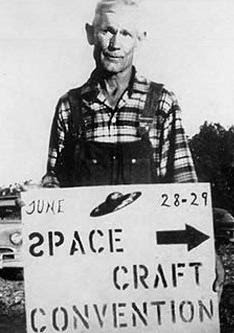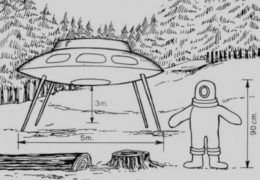by Charles Lear
 The year 1957 was a very interesting one in UFO history. In that year, UFO occupant reports were accepted as worthy of investigation by serious organizations such as the Aerial Phenomena Research Organization and Civilian Saucer Intelligence of New York; Contactees were in the spotlight thanks to the Long John Nebel Show; and Maj. Donald Keyhoe USMC ret. became the director of the National Investigations Committee on Aerial Phenomena. The main question in the early days of flying saucers had been whether or not they came from outer space. The Air Force had assured the public that they were working to find the answers to the mystery, but now the public’s faith in the Air Force was waning and the mystery was more complex. Who to believe and what to believe were now complicated by competing factions and commercial interests. A person could get in there and diligently research and investigate, sit back and enjoy the circus or join the circus and cash in.
The year 1957 was a very interesting one in UFO history. In that year, UFO occupant reports were accepted as worthy of investigation by serious organizations such as the Aerial Phenomena Research Organization and Civilian Saucer Intelligence of New York; Contactees were in the spotlight thanks to the Long John Nebel Show; and Maj. Donald Keyhoe USMC ret. became the director of the National Investigations Committee on Aerial Phenomena. The main question in the early days of flying saucers had been whether or not they came from outer space. The Air Force had assured the public that they were working to find the answers to the mystery, but now the public’s faith in the Air Force was waning and the mystery was more complex. Who to believe and what to believe were now complicated by competing factions and commercial interests. A person could get in there and diligently research and investigate, sit back and enjoy the circus or join the circus and cash in.
The editorial in the May, 1957 CSI News Letter No. 19, “The Price of Being Too Factual,” encapsulates the state of UFOlogy at that time. It begins with the announcement that Leonard Stringfield will no longer be issuing the periodical Orbit. This was the newsletter for his organization, Civilian Research Interplanetary Flying Objects. Stringfield had a reputation for being a no-nonsense investigator and was a trusted source for sightings reports. That he was unable to cover his printing costs while a “tongue-in cheek entertainer,” like John Nebel, and “a purveyor of a gospel,” such as George Adamski, were able to maintain a mass audience is noted as boding “ill for the future of UFO research.” Providing hope is the news that NICAP is under new management and the writer ends by encouraging readers to support the organization and that “it’s time to put up or shut up.”
NICAP was founded in 1956 by T. Townsend Brown, who claimed to have developed an anti-gravity device. Keyhoe had been instrumental in recruiting many prominent people, including Rear Adm. Delmar C. Fahrney USN ret., to sit on NICAP’s board of governors. NICAP had lofty ambitions and having a paid, full-time staff was one of them. An $85,000 a year payroll for that staff, which included Brown, was “suggested” and an argument ensued that resulted in Brown leaving and Keyhoe taking over as director.
Keyhoe had been accusing the Air Force of withholding information from the public and immediately got to work to pry that information loose. The Air Force was on notice and they prepared themselves for the public relations war to come. Keyhoe pushed for answers, asked to review Project Blue Book conclusions and was deflected, denied, and ignored. He finally made use of his influences in the military and managed to get the United States Senate Committee on Government Operations to start an inquiry into UFOs in Nov. 1957. Former Blue Book director, Edward J. Ruppelt was called to testify and he later described NICAP as having pounded the deepest thorn of any “into the UFO side of the Air Force.”
While this was going on, public perception of the UFO community was being strongly influenced by the outrageous claims and antics of the contactees. George Van Tassel held his fourth annual Interplanetary Spacecraft Convention at Giant Rock in California, which was featured in the May 27, 1957 issue of Life magazine. It was attended by true believers in the space brothers and sisters and people selling books about their travels with them to Venus and Mars. One contactee, Buck Nelson, held conventions on his farm in Missouri. There, he sold copies of his 1956 book, “My Trip to Mars, the Moon, and Venus,” as well as bags of hair, which he claimed came from a 385 lb space dog named Bo. Nelson is the man seen holding a sign promoting his Space Convention with a backwards “S” in a well-known picture.
 Serious organizations, such as APRO and CSI, did their best to keep their distance. Jim Moseley, devoted the Nov. 1957 issue of his publication, Saucer News, to an expose of the proto-contactee, George Adamski. APRO and CSI evaluated contactees in their publications as they came forward and discounted all their claims. Gray Barker, Flatwoods Monster investigator and author of “They Knew Too Much About Flying Saucers,” was an exception and he actually published a book by late-comer contactee, Howard Menger. Jackie Gleason harshly criticized Barker for this on The Long John Nebel Show. Barker was gaining a reputation for being less discriminating than most of the “serious” researchers. Because of this, he ended up becoming marginalized in the community and was not invited to speak at certain conferences.
Serious organizations, such as APRO and CSI, did their best to keep their distance. Jim Moseley, devoted the Nov. 1957 issue of his publication, Saucer News, to an expose of the proto-contactee, George Adamski. APRO and CSI evaluated contactees in their publications as they came forward and discounted all their claims. Gray Barker, Flatwoods Monster investigator and author of “They Knew Too Much About Flying Saucers,” was an exception and he actually published a book by late-comer contactee, Howard Menger. Jackie Gleason harshly criticized Barker for this on The Long John Nebel Show. Barker was gaining a reputation for being less discriminating than most of the “serious” researchers. Because of this, he ended up becoming marginalized in the community and was not invited to speak at certain conferences.
While contactees and their supporters were considered unworthy of consideration by many researchers, humanoids, hairy dwarves and silver goblins were welcome in the case files of both CSI and APRO. Reports were coming in from all over the globe since publicity surrounding a 1954 French wave introduced humanoid encounters to the world at large. CSI investigator, Isabel Davis, published her and Bud Ledwith’s account of the 1955 Kelly-Hopkinsville case and it was a hot item among researchers in 1957. Then, in Oct. of that year, a Brazilian farmer had an encounter that brought humanoid encounters to a new level.
On Oct. 15, 23-year old Antônio Villas Boas was driving a tractor, tilling a field on his family’s farm. It was 1:00 a.m. (he was working at night to avoid the heat of day) and, according to him, a red light appeared in the sky. It came towards him quickly and stopped over him. It then came down as if landing and he left his tractor to investigate. He saw it was an object shaped like “a large elongated egg” with three landing legs. Scared, he ran back to his tractor. When he got to it, its engine and lights died.
He was then grabbed by a humanoid being in a space suit. It was smaller than he was and only came up to his shoulder. Three more appeared, they overpowered him and took him to their craft. There, he was stripped, covered in gel and then left alone on a couch in the middle of the room. A suffocating gas was introduced that made him nauseous. He vomited and then breathed easier. A short while later, a naked female alien with cat-like eyes, a pointed chin and bright red pubic hair entered and seduced him. They had sex twice and then one of the humanoids called her away. She smiled at Boas, touched her belly and pointed at the sky.
Boas was then given a tour of the ship. He saw what resembled a clock and tried to hide it with the hope of having some proof of his experience. It was noticed by one of the creatures and taken from him. He was released and the craft flew away with the speed of a bullet. It was then 5:30 a.m.
Brazilian journalist, João Martins, had written the first of a series of articles titled, “Flying Saucers’ Terrible Mission” for the magazine O Cruzeiro. He described people being attacked by small humanoids and asked readers to write to him with their own experiences. Boas wrote to him one day after reading the article and Martins responded. The next year he paid Boas’ fare to Rio de Janeiro where he was examined by Dr. Olavo Fontes. Fontes was an APRO associate and he gave his report to them. The case was too controversial for them to publish in the APRO Bulletin. It remained known only to a few researchers until an account by Brazilian researcher, Walter Buhler, was published in the Jan. 1965 Flying Saucer Review.
An aspect of note in the Boas case is his report that his tractor’s engine and lights died in the proximity of a UFO. This was a new thing in 1957, but there were many instances like it reported that year. The most famous case came from Levelland, Texas. Overnight from Nov. 2-3, large flying objects were reported along with car, truck and farm equipment failures. This would have been a good case for NICAP, but its man on the scene was James A. Lee. Lee was an eccentric who had his own ideas about the nature of the universe due to decades of studying all sorts of esoteric books. He believed that space was made up of ether, that the vortex of the ethers held all things on Earth, and that tornadoes were caused by leftover energy from God’s creation of the Earth.
Lee had been in the news that year prior to the events at Levelland. He was reported to have patrolled the area around Van Tassel’s convention in his 1949 Cadillac. He called the car his “Space Wagon” and it was equipped with an “infrared beam detector” designed to ferret out any outer space based spies who might have been looking in on the convention.
After a careful investigation at Levelland, that included taped interviews of witnesses (lost to history at present), Lee’s well thought out conclusion was that people had seen a spaceship. In the November 6 edition of The Abilene Reporter-News, an article notes Lee’s speculation on why a spaceship might come to Levelland. He felt the spaceship might have been drawn there because of a lecture on UFOs he was scheduled to give that Sunday in Brownfield, 29 miles south of Levelland. The Air Force concluded the cause of the reports was ball lightning, which had a basis in science equal to Lee’s conclusion.
It had been ten years since the flying saucer mystery first came to public attention and it became “curiouser and curiouser” over the succeeding years. Where an investigator drew the line between crackpot and credible was a difficult choice as they risked harsh criticism from others in the community. Things wouldn’t get any easier.